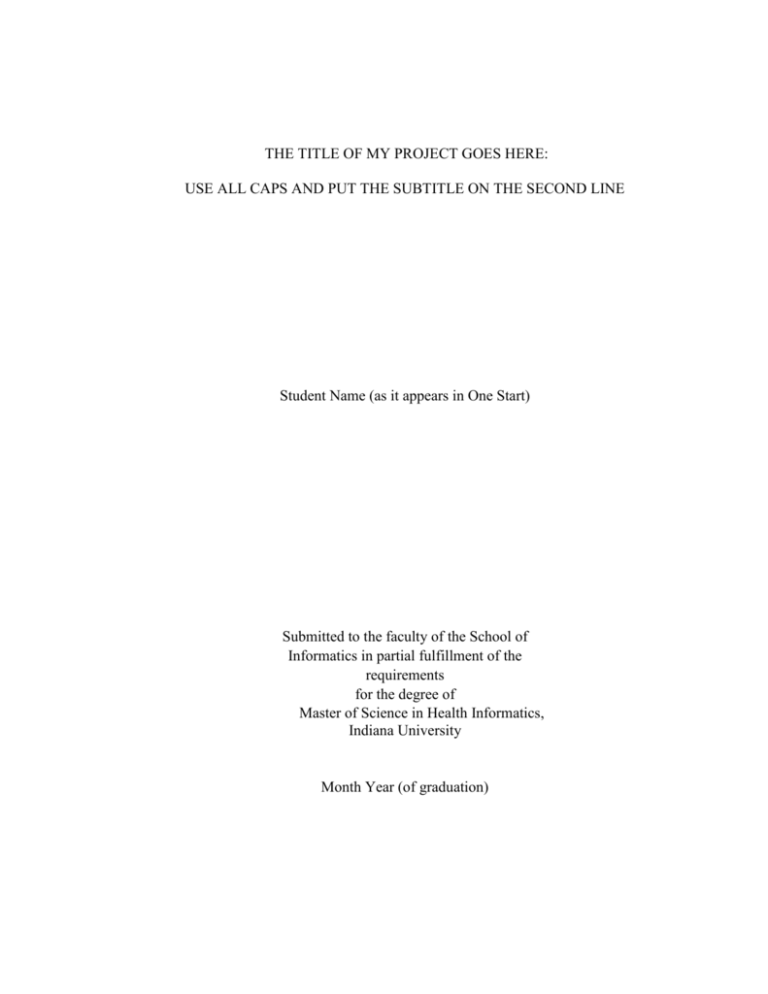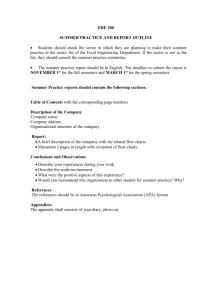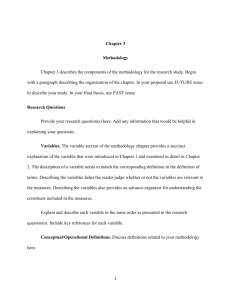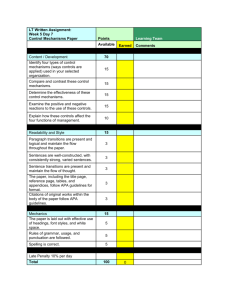
THE TITLE OF MY PROJECT GOES HERE:
USE ALL CAPS AND PUT THE SUBTITLE ON THE SECOND LINE
Student Name (as it appears in One Start)
Submitted to the faculty of the School of
Informatics in partial fulfillment of the
requirements
for the degree of
Master of Science in Health Informatics,
Indiana University
Month Year (of graduation)
Accepted by the Faculty of Indiana University,
in partial fulfillment of the requirements for the degree of
Master of Science in Health Informatics
Master’s Proposal
Committee
________________________________________
Faculty Advisor Name, Degree Title
________________________________________
Committee Member Name, Degree Title
© 20XX
Sammy Student
ALL RIGHTS RESERVED
Dedication (Optional)
This is an optional page for a dedication. If you include a dedication, use regular
paragraph spacing as shown here (not centered, italicized, or otherwise formatted). If you
do not wish to include this page, delete the heading, the body text, and the page break
below the end of the text.
Table of Contents
LIST OF TABLES ............................................................................................................. iii
LIST OF FIGURES ........................................................................................................... iv
ACKNOWLEDGEMENTS (Optional) ...............................................................................v
ABSTRACT .........................................................................................................................1
CHAPTER ONE: INTRODUCTION & SIGNIFICANCE OF PROJECT .........................2
Subsection 1 ...................................................................................................................2
Subsection 2 ...................................................................................................................2
CHAPER TWO: LITERATURE REVIEW ........................................................................3
Subsection 1 ...................................................................................................................3
Subsection 2 ...................................................................................................................3
Problem Statement .........................................................................................................3
CHAPTER THREE: APPROACH TO SOLUTION ...........................................................4
Suggested Approaches to Solve Problem ......................................................................4
Procedures to Solve Problem .........................................................................................4
CHAPTER FOUR: FINAL PROJECT DEVELOP .............................................................5
Developed Project (Outcomes) ......................................................................................5
Suggested Evaluation Method .......................................................................................5
CHAPTER FIVE: DISCUSSION ........................................................................................6
Explanation of Outcomes ...............................................................................................6
Implications of Results ..................................................................................................6
Summary of Discussion .................................................................................................6
i
CHAPTER SIX: CONCLUSION ........................................................................................7
Limitations (i.e., limitations or problems with the project or outcomes) ......................7
Suggested Applications (if applicable) ..........................................................................7
Summary ........................................................................................................................7
REFERENCE .......................................................................................................................8
APPENDICES (Optional) ..................................................................................................10
Appendix A: Prototype ................................................................................................10
CV…… ..............................................................................................................................11
Use this table of contents (TOC) as an example of what one looks like. When it comes
time for creating your own TOC, RIGHT CLICK anywhere in the Table of Contents,
select UPDATE FIELD, then select UPDATE ENTIRE TABLE or UPDATE PAGE
NUMBERS ONLY, and click OK.
The table of contents will be generated using the style tags from the template; you will
also be able to automatically update the TOC, both added headings and page numbers.
ii
LIST OF TABLES
Table 4.1 A Sample Table Showing Correct Formatting .................................................... 5
When you update the list of tables, the table number and title will come in without
a period between them; you will need to manually add that period after all table numbers,
as shown for Table 1. In addition, the title will retain the italics from the narrative when
the List of Tables is updated. Once your list is finalized, select the entire list and change
it all plain type.
iii
LIST OF FIGURES
Figure 4.1. Figure caption goes here ..................................................................................xx
The List of Figures is not set up to automatically update. If you have figures in
your document, type them in manually here, following the example above.
iv
ACKNOWLEDGEMENTS (Optional)
This is an optional page for acknowledgments. It is a nice place to thank the
faculty, family members, and friends who have helped you reach this point in your
academic career.
No page number appears on any of the pages up to this point. If you do not wish
to include this page, delete the heading and the body text; if a blank page remains, delete
the page break above but leave the section break that you see below this text.
v
ABSTRACT
Student Name (as it appears in One Start)
TITLE OF PROJECT IN ALL CAPS AGAIN
In this document, I have attempted to create a report template to give students an
example of the formatting style that must be followed. Obviously, all the sections would
be longer than one page (as shown in the document), but this should provide a general
guideline. Keep abstract to one page, around 200 words max. The abstract should give a
brief overview of the literature review and each section of the project report, especially
the findings and their implications. The report should be about 20,000 words, not
including the reference section and appendices. If you are less than 10,000 (not including
the reference section), you may want to reconsider some places that may need more depth
in the literature review, methodology, or discussion section. For example, make sure you
adequately outline why your findings are relevant and contribute to your field in the way
of new knowledge. Ultimately, the length of your report should be discussed and agreed
upon with the chair of your committee. You must follow the Table of Contents page for
the order of your project report content. However, you may have additional subsections
than listed here. Also, follow this document for page formatting, pagination, footnotes,
and margins. The entire project report must be in Time Roman 12pt type. Font and font
size may be varied for symbols or emphasis when appropriate (e.g., for scientific or
mathematic terms).
[READ THIS ABSTRACT ABOVE.]
1
CHAPTER ONE: INTRODUCTION & SIGNIFICANCE OF PROJECT
Subsection 1
Begin text here.
Subsection 2
…………continued…………….
2
CHAPER TWO: LITERATURE REVIEW
Subsection 1
Insert the text of your literature review here. Report the literature in past tense, as
in Jones (2003) argued, not Jones (2003) argues.
Here are some additional tips for presenting data in vertical list form.
1. In the body of your paper, use this format when presenting information as a
vertical list.
2. When the order of the items in the list is important, use a numbered list. Use a
bulleted vertical list when you do not need to indicate a certain order or
chronology.
This is an example of a bulleted list.
It follows the same format as for a numbered list, with the bullet point
indented the same as a paragraph indent.
Subsection 2
…………continued…………….
Problem Statement
…………continued…………….
3
CHAPTER THREE: APPROACH TO SOLUTION
Suggested Approaches to Solve Problem
Discuss your approaches here, including the rationale on why you select this
specific approach.
…………continued…………….
Procedures to Solve Problem
Discuss your procedures in detail step by step.
…………continued…………….
4
CHAPTER FOUR: FINAL PROJECT DEVELOP
Developed Project (Outcomes)
Present how the finalized project looks like.
This is an example of a table in APA style (see Table 4.1).
Table 4.1
A Sample Table Showing Correct Formatting
Column 1
Column 2
Column 3
Column 4
Row 1
Row 2
Row 3
Row 4
Table 4.1. Name of table
…………continued…………….
Suggested Evaluation Method
This is an example of a figure labeled per APA style. Note that the label is placed
under the figure itself. As with tables, refer to the figure by number in the narrative text
preceding the placement of the figure (see Figure 1).
[Place figure here]
Figure 4.1. This is a sample of a figure caption.
5
…………continued…………….
CHAPTER FIVE: DISCUSSION
Explanation of Outcomes
Insert discussions here.
…………continued…………….
Implications of Results
…………continued…………….
Summary of Discussion
…………continued…………….
6
CHAPTER SIX: CONCLUSION
Limitations (i.e., limitations or problems with the project or outcomes)
Insert conclusions, and recommendations here.
…………continued…………….
Suggested Applications (if applicable)
…………continued…………….
Summary
…………continued…………….
7
REFERENCE
Insert References here. Examples of some common types of references follow; see APA
6.22 and Chapter 7 for more details.
These sample entries are tagged with the “APA Reference” style tag, which means the
line spacing and hanging indent are automatic. Apply the “APA Reference” style
tag to your entries.
Pay special attention to italics, capitalization, and punctuation. The style tag does not
govern those aspects of the entry.
Periodical (journal)
Author, A. A., Author, B. B., & Author, C. C. (1994). Title of article. Title of Periodical,
xx(x), xxx-xxx.
Online periodical (journal)
Author, A. A., Author, B. B., & Author, C. C. (1994). Title of article. Title of Periodical,
xx(x), xxx-xxx. doi: xxxxxx
Nonperiodical (book)
Author, A. A. (1994). Title of work. City of Publication, ST: Publisher.
Chapter in a book
Author, A. A., & Author, B. B. (1994). Title of chapter. In A. Editor, B. Editor, & C.
Editor (Eds.), Title of book (pp. xxx-xxx). City, ST: Publisher.
The Publication Manual of the American Psychological Association, Sixth
Edition, Chapter 7, includes numerous examples of reference list entries. For more
8
information on references or APA style, consult the APA website.
(http://www.apastyle.org/learn/faqs/index.aspx).
9
APPENDICES (Optional)
Appendix A: Prototype
Insert appendix here. Appendices are ordered with letters rather than numbers.
If the only thing in an appendix is a table, the table title serves as the title of the
appendix; no label is needed for the table itself. If you have text in addition to a table or
tables in an appendix, label the table with the letter of the appendix (e.g., Table A1, Table
A2, Table B1, and so on). These tables would be listed in the List of Tables at the end of
the Table of Contents.
If you include in an appendix any prepublished materials that are not in the public
domain, you must also include permission to do so.
10
CV
Include a copy of your curriculum vitae—your academic resume—here. The CV
may be done in either basic outline form or full-sentence form. The CV must conform to
the margin specifications of the rest of the document, be included in the pagination, and
be listed in the TOC.
(Keep the Vita to one page)
Sammy Student
sammy@yahoo.com
(317) 332-7191 2222
Woodfront Pl.
Farmland, IN, 46222 USA
Education
Master of Science in Human-Computer Interaction, Expected May 2005
School of Informatics, Indiana University Purdue University at Indianapolis (IUPUI)
Thesis: Web-based Email Management for Email Overload
Advisor: Anthony Faiola
• Web-based Email Management for Email Overload is the study that focused on
designing web-based email prototype to handle email overload problem.
Bachelor of Engineering in Computer Engineering, March 2002
University, USA
Project: HCI for everyone.
Research Interests
•
•
Usability design for web applications
Usability design for computer music applications
11
Experiences
Web programmer, Department of New Media, IUPUI, Indianapolis, IN
Jan 2005 – Apr 2005
• Developed web-based applications using PHP, MySQL, and JavaScript for
Mathematics department
Etc………
12






